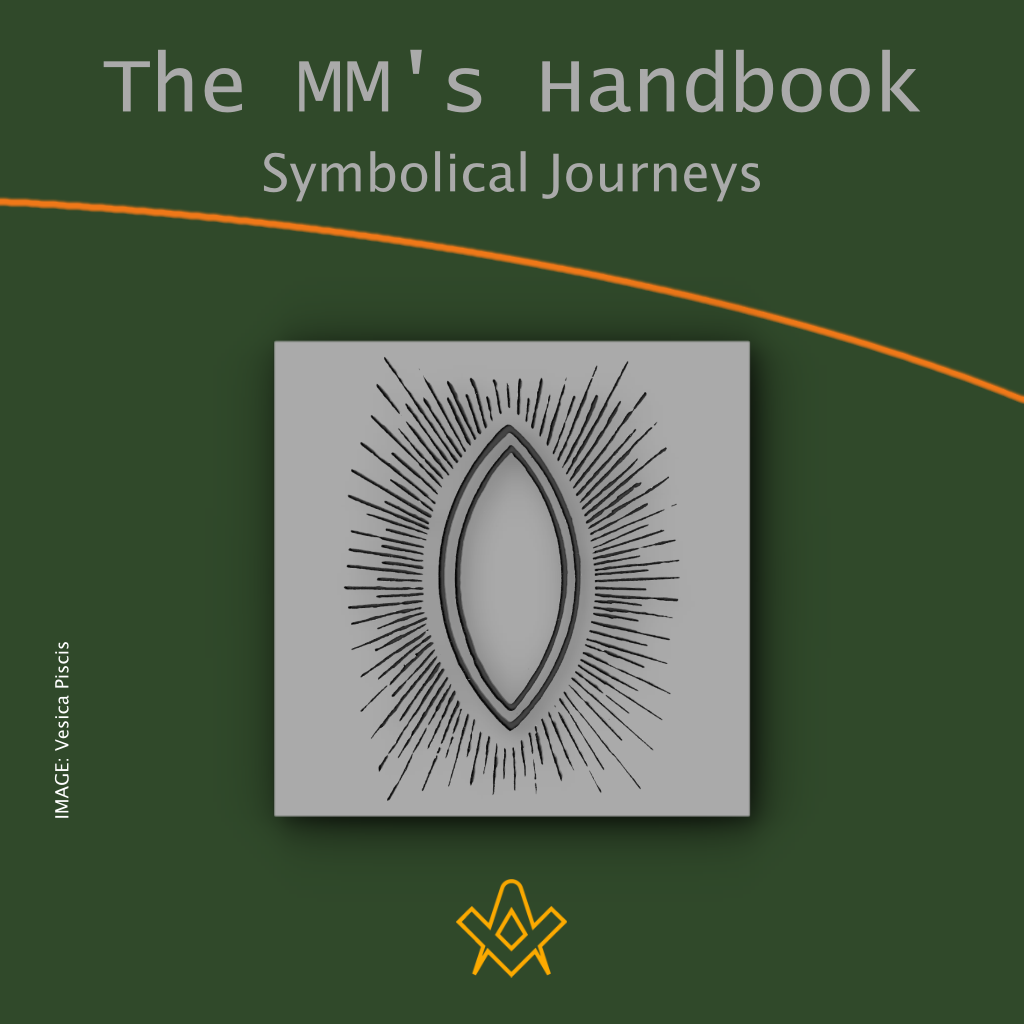The Candidate is admitted on the compasses, and this fact is of far greater significance than most brethren probably realize.
Chapter III – The Symbolical Journeys
Firstly, as has been noted, one arm of the compass is always at the centre no matter how far the other may travel, and from the point of view of the candidate, though he knows it not, this act in a sense indicates that his heart, and therefore he himself, is at or on the centre.
Secondly, the compass in this degree link up with the square used in the former degree on a similar occasion.
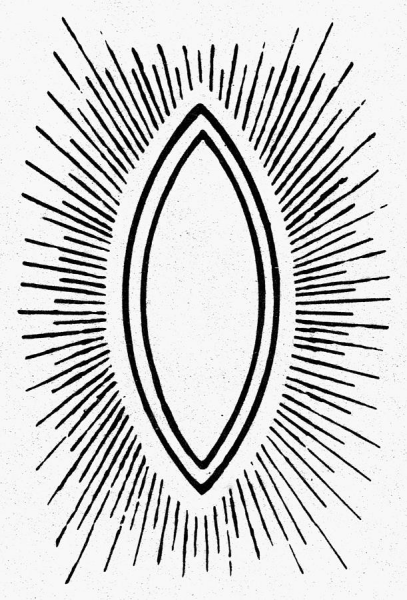
Vesica Piscis
IMAGE LINKED: wikimedia Attribution 4.0 International (CC BY 4.0)
We have seen in the previous books that the square and compasses are united on the pedestal in such a way as to form the Vesica Piscis, the emblem of the female principle, and the symbol of birth and rebirth. Hence symbolically the Candidate passes through the Vesica Piscis.
Also, after entering the Lodge in this, as in the previous degrees, he kneels while the blessing of Heaven is invoked, and as he does so the wands of the deacons are crossed above his head.
He thus kneels in a triangle, the emblem of Spirit, and itself connected with the lozenge. Two equilateral triangles make a lozenge, which is produced from the Vesica formed-formed by two circles, as shown by the first proposition in Euclid.
In view of the great stress laid upon Geometry throughout the whole of our rituals these facts cannot be ignored.
Our Operative Brethren must have realized that the whole science of Geometry arises out of this first proposition, which shows how to make a triangle (the emblem of the Trinity and the Spirit) by means of two circles whose circumferences pass through the centre of each other.
In doing so they form the Vesica formed, which gives birth first of all to the triangle, and secondly, to the double triangle, in the form of a lozenge. This last emblem is symbolized by the square denoting matter, and the compasses, denoting spirit.
The above facts throw a flood of light upon the interplay between these Masonic emblems.
Before leaving this subject it is worthwhile pointing out that the candidate likewise takes every obligation in Craft masonry within this triangle, and that the same method is employed in other ancient rites, including those of the Society of Heaven and Earth in China, where the candidate kneels on one sword, while two others are held over his head so as to form a triangle of steel.
The candidate now starts on his three symbolical journeys. He first satisfies the J.W., representing the Body, that he is an Entered Apprentice i.e., a man of good moral character.
He next satisfies the S.W., representing the Soul, that he has benefited by the lessons of life and acquired intellectual knowledge.
Then comes the third journey, when he is once more challenged by the Soul, who demands the password the full significance of which has already been explained.
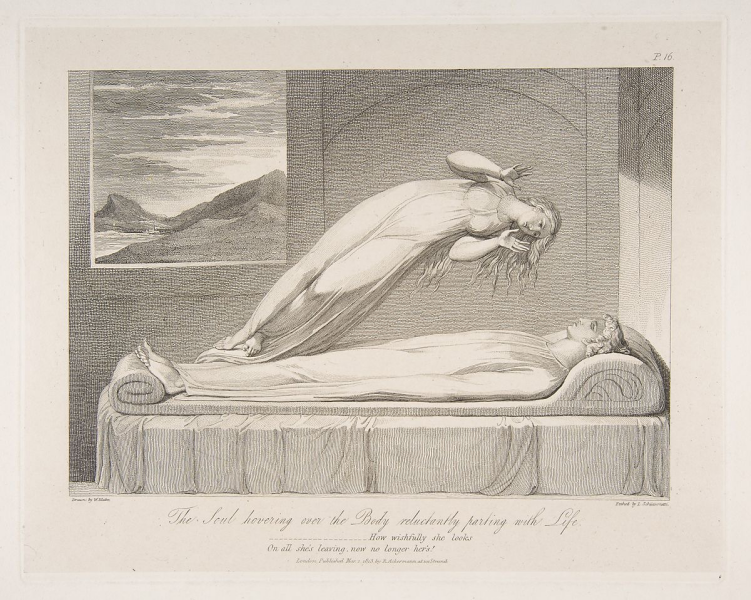
IMAGE LINKED: wikimedia Attribution 4.0 International (CC BY 4.0)
Let us combine these meanings! He comes laden with worldly possessions, which in themselves carry the seeds of death, unconsciously representing in his person the worker in metals who made the twin columns and is about to be entombed. (tymboxein).
Therefore the Soul presents him to the Spirit as one properly prepared to carry out the part of his great predecessor.
There is a point here which we need to realize, for it is one which is often overlooked. In the previous degrees only one Deacon was instructed to lead the candidate by the proper steps to the east, but here both are needed.
From the practical point of view there is no obvious reason why the help of the J.D. should be invoked at all, and as the ceremony is usually carried out he does nothing but look on.
I believe, however, the S.D. should first go through the steps and the J.D., should assist the candidate to copy his example.
If thus were so we should get an almost exact repetition of the analogous ceremony in the Royal Arch where the Principle Sojourner, corresponding to the S.D., is helped by an assistant.
Thus, with the candidate, in both cases we get a Trinity, only one of whom actually descends into the grave, or, in the other case, into the vault.
As Major Sanderson has pointed out in An Examination of the Masonic Ritual, among the primitive, races usually, a man who stepped over an open grave would be considered to have committed sacrilege, and almost certainly would be slain, but, on the other hand, we do know that in many Initiatory Rites either the candidate, or someone else for him, steps down into a grave, and is subsequently symbolically slain therein.
If this be the true interpretation of this part of the ceremony, the reason for the presence of the two deacons in addition to the candidate becomes clear. It is only the Body that descends into the clear the Soul and the Spirit have no part therein.
Thus, for the moment, though only temporarily, these three represent the triune nature of man, while the three principal officers represent the triune nature of God. The fact that this is undoubtedly true in the case of the Royal Arch, makes it almost certain that the same idea underlies this apparently unimportant difference between the arrangements in the third degree, and those followed in the first and second.
Again and again when one comes to study carefully the details of our ritual, one finds little points, such as these, which would certainly not have survived the drastic revision of 1816 if there had not been present some men who really did understand the inner meaning of our ceremonies, and refused to allow important lessons to be lost by the removal of what, at first sight, appear to be unnecessary details.
Therefore, those of us who value the inner meaning of our ceremonies owe a deep debt of gratitude to these men, even though their actual names be unknown to us, and on our part a duty is imposed on us that we shall not hastily tamper with the rituals, merely because we do not ourselves see the full significance of a phrase or think that by revising it we can make the wording run more smoothly.
The next factor we must consider most careful is the actual steps themselves. These make the Latin cross of suffering and sacrifice.
Sometimes the steps are not done quite correctly, for the candidate should be careful to face due North, due South, and due East respectively.
This procedure undoubtedly refers to the three entrances of the Temple through which H.A.B. endeavoured to escape. Hence it is we see that the Master himself trod out the cross of Calvary during the tragedy, and in a sense made the Consecration Cross of the Temple.
In a mediaeval church, and even to-day at the consecration of a church according to the Anglican ordinance, there should be a dedication cross marked on the building.
In the Middle Ages these were usually marked on the pillars, and apparently corresponded to the mark made by an illiterate person when witnessing a deed.
The Consecrating Bishop sometimes drew this cross on the pillar or wall, or sometimes merely traced over a cross already painted there for the purpose. Any new piece of work in a church, even if only a new fresco, had its dedication cross.
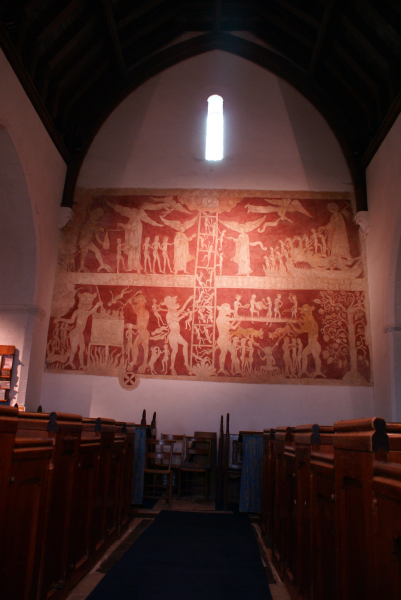
Day of Judgement – Ladder of Salvation of the Human Soul. Note the ‘Bridge of Dread’ featuring various tradesmen including a mason. In the margin, bottom left, there is a ‘Consecration Cross’.
Medieval mural in St Peter and St Paul Church, Chaldon, England.
IMAGE CREDIT: Ian David Rees (CC BY-SA 2.0)
For example: At Chaldon Church, Surrey, the dedication cross is marked on the margin of a fresco depicting “The Brig of Dread“, described at length in “Freemasonry and the Ancient Gods”.
Bearing these facts in mind, we shall perceive that, even from the Operative point of view, the manner of advancing in this degree, and the manner in which Hiram Abiff met his end, had a peculiar significance.
The Great Architect of the Temple must have traced the dedication cross the whole length and breadth of the Temple in his own blood. Moreover, such dedication crosses as have actually survived are nearly always found to be painted in red.
Thus, Hiram Abiff’s last work was, as it were, to commence the consecration of the Temple which was completed by King Solomon, for until that cross had been marked either on the wail or pavement, according to mediaeval Operative ideas the building could not be consecrated.
Therefore, the candidate, who is re-enacting the same drama, must obviously do likewise, and in so doing dedicates the Temple of his body.
But there is still more hidden within this ceremonial act. The ancient Knights Templar were accused of trampling on the cross, and a careful examination of the evidence taken at the trial shows that in reality they took a ritual steps somewhat similar to those taken by the candidate in this degree.
One of the esoteric meanings indicated is the Way of the Cross which leads to Calvary. Furthermore, having thus traced out a cross he is subsequently laid on it, and this fact is emphasized by the position in which his legs or feet are placed. The foot of this cross reaches to the pedestal on which rests the Old Testament.
If, therefore, this symbolical cross. were raised as it was on Calvary it would rest on the Old Testament, and the candidate would face the East, and would be, as it were, on a mountain.
This fact should be borne in mind by those who seek a Christian interpretation of our Craft ceremonies. Mystically interpreted, it indicates that every aspirant for union with the Divine must tread the Way of the Cross, and suffer and die thereon, in order that he may rise to a new life, a realization of his union with the Infinite.
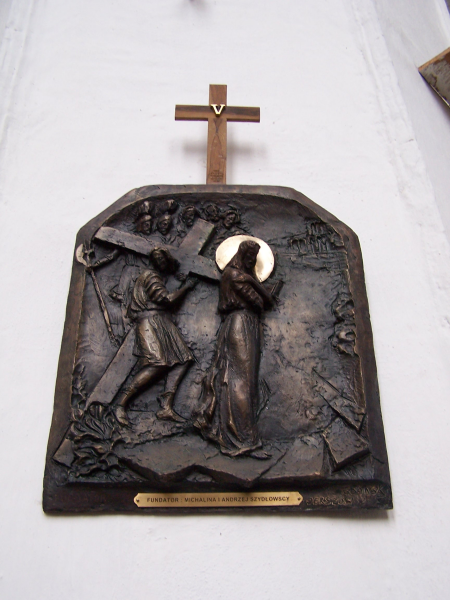
“The way of the Cross” by Gennadiy Jerszow – 14 relief images (bronze) Basilica of the Assumption of the Virgin Mary. Gdańsk, Poland.
IMAGE LINKED: wikimedia Attribution 4.0 International (CC BY 4.0)
Even those who are disinclined to admit the possibility of a Christian interpretation, of the Craft degrees, must recognize the fact that this cross is the cross of sacrifice and means that the true aspirant must be prepared to sacrifice everything in his search after Truth.
The number of the steps is the combination of the Trinity and of the four elements, representing matter.
It is the same number as forms the perfect lodge, and also the seven elements which form man, whether we interpret it according to the ancient Egyptian system, or in the more modern form of the five physical senses, the Soul and the Spirit.
In the latter case it indicates that the man must be prepared to sacrifice, or shall we say dedicate to God, Body, Soul and Spirit.
There are yet other profound meanings in this one ritual act, but enough has been written to set my readers pondering for themselves, and we will therefore proceed to consider the next point in the ceremony.
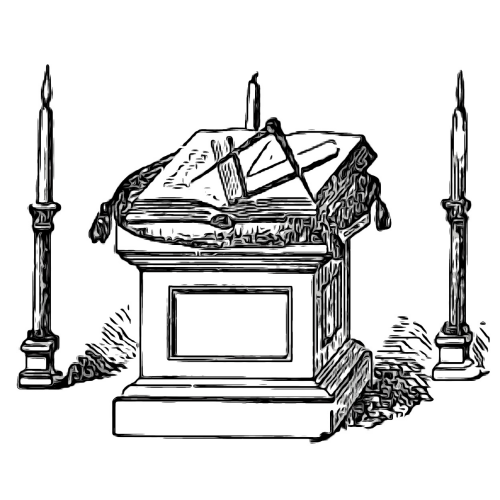
The obligation itself contains one or two interesting points. Thus it indicates that a M.M.s Lodge must always be open on the centre.
This shows us at once that we are dealing with a ceremony with a mystical meaning, for the centre means the same as the middle chamber in the second degree – the secret chamber of the heart, where dwells the Divine Spark – and so tells us in veiled language that all that happens thereafter is a spiritual experience, which sooner or later comes to every mystic.
The special moral obligations which the candidate undertakes should be noted, but require no explanation.
It is, however, difficult to understand why they should be deferred until this stage. In the ancient charges similar obligations are imposed apparently on the Entered Apprentices and this seems more logical.
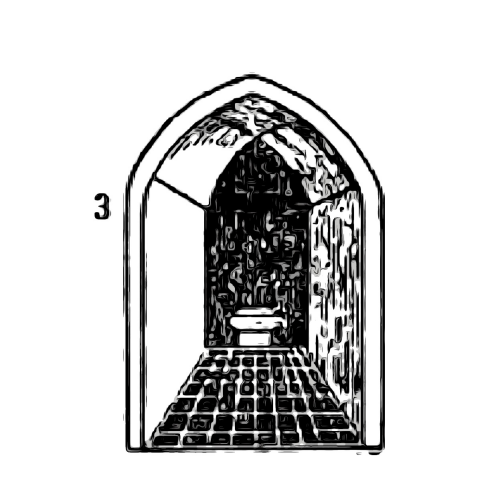
The prayer varies even in different parts of England, but in essentials is always the same.
You are south at the centre, and the manner of disposal is very reminiscent of the way in which the dead are cremated in India in honour of Shiva.
There the corpse is burnt near running water, preferably near the Ganges, and the ashes are thrown into the air over the river to the four cardinal points, that the winds may scatter them.
It must be remembered that Shiva represents the destructive attribute of the Deity and he makes the P.S. of a Master Mason on his statues. His is the element of fire, and all these facts must be born in mind when considering our own prayer.
The position of the square and compasses, in addition to the explanation given, indicates that the spirit, represented by the compasses, now dominates the body, typified by the Square.
Article by: J. S. M. Ward
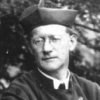
John Sebastian Marlow Ward (22 December 1885 – 1949) was an English author who published widely on the subject of Freemasonry and esotericism.
He was born in what is now Belize. In 1908 he graduated from the University of Cambridge with honours in history, following in the footsteps of his father, Herbert Ward who had also studied in history before entering the priesthood in the Anglican Church, as his father had done before him.
John Ward became a prolific and sometimes controversial writer on a wide variety of topics. He made contributions to the history of Freemasonry and other secret societies.
He was also a psychic medium or spiritualist, a prominent churchman and is still seen by some as a mystic and modern-day prophet.
Recent Articles: Master Mason's Handook J.S.M Ward

Book Review - The EA, FC, MM Handbooks
Essential reading for every Entered Apprentice, Fellowcraft, and Master Mason - these seminal books by J.S.M Ward are what every Mason needs!
more....
 The Master Mason's Handbook P1 Chapter 1 - Questions and Password; a brief explanation of the teaching of the third degree as contained in the symbols by J.S.M Ward |
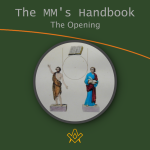 The Master Mason's Handbook P2 Chapter 2 - The Opening; a brief explanation of the teaching of the third degree as contained in the symbols by J.S.M Ward |
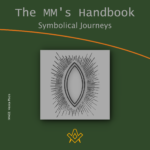 The Master Mason's Handbook P3 Chapter 3 - The Symbolical Journeys; We have seen in the previous books that the square and compasses are united on the pedestal in such a way as to form the Vesica Piscis, the emblem of the female principle, and the symbol of birth and rebirth. Hence symbolically the Candidate passes through the Vesica Piscis. |
 The Master Mason's Handbook P4 Chapter 4 - The Exhortation The opening part of the exhortation gives a convenient summary of the previous degrees and quite clearly indicates that the first inner meaning of the series is Birth, Life which is of course educational and preparatory for its sequel, and Death. |
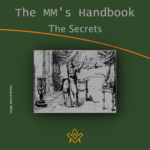 The Master Mason's Handbook P5 Chapter 5 - The Secrets. Having thus been brought into the place of light the Candidate is given not the genuine secrets, but only substituted ones. This fact must often have puzzled the Candidate. The practical reason given in the ritual, though perfectly intelligible to a Royal Arch mason (Companion) , cannot be the real one. |
 The Master Mason's Handbook P6 Chapter 6 - The Badge - On his re-entering the Lodge, the candidate is presented and in due course invested with the badge of a Master Mason by the S.W. The Badge itself, however, is full of symbolic meaning…. |
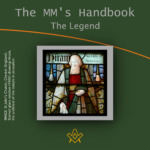 The Master Mason's Handbook P7 Chapter 7 - The Legend - After the ceremonial investiture of the Candidate the W.M. continues the narrative of the traditional history. At least this is the case in most English workings, but in some Scotch workings the whole story is told first, and subsequently the Candidate and the other brethren act the chief parts. Perhaps one of the most important points to realise is the correct meaning of the name Hiram Abiff . |
 The Master Mason's Handbook P8 Chapter 8 - The Tracing Board - The next part of the narrative is incorporated in most English workings with the Tracing Board. The most interesting feature is the description of the grave. It is obvious that peculiar stress is laid on the centre, even in the present form of our ritual, because of the way in which the measurements are given. |
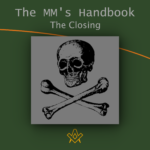 The Master Mason's Handbook P9/10 Chapters 9 & 10 The Closing Finally, even if a man can never fathom the full meaning of the third degree, yet there is no man worthy of the name who has passed through that third degree but will certainly have learnt one important lesson, namely, how to die, and thereby will be the better man. |
masonic knowledge
to be a better citizen of the world
share the square with two brothers

click image to open email app on mobile device



